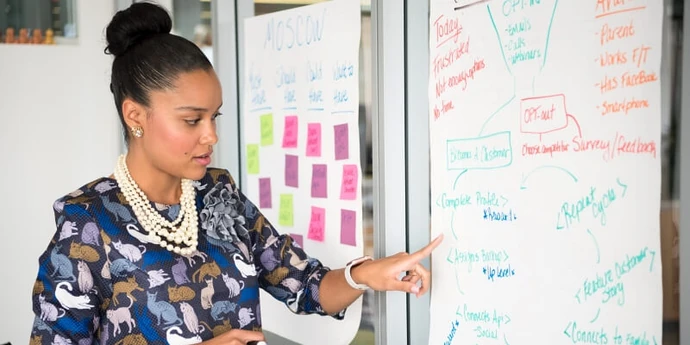This article was written in collaboration with interview coach Nupur D. A former Technical Program Manager for Google, Nupur has coached more than 300 people over her career. She currently works as a TPM for a fintech company in India.
Demonstrating leadership will be one of the key drivers influencing the level at which you’re hired in companies like Amazon, Meta, and Google. This won’t be limited to one interview; in fact, you will have to show off your leadership skills throughout the interview process.
Candidates at every experience level need to be able to demonstrate their ability to influence projects and people, with or without organizational authority. Illustrating this thoroughly can be difficult in an interview setting.
So we’ve put together the following guide to demonstrating leadership in tech interviews, with an overview of the top leadership competencies, practice interview questions, and a step-by-step preparation guide.
Here’s a brief overview of what we’ll cover:
Click here to practice 1-to-1 with ex-FAANG interviewers
1. What is leadership?
The terms “leadership” and “people management” used to be synonymous, but their definitions diverged with the explosion of tech and startup culture in Silicon Valley. Today, leadership reflects an attitude.
While only some employees are managers, all employees are expected to be leaders. So managing and leading require separate skill sets and should be addressed differently in an interview setting.
Managers cover a lot of ground. They’re in charge of the productivity, happiness, and career advancement of their team. Management often involves hiring, onboarding, training, motivating, retaining, offboarding, etc.
Leadership is about how you influence and impact both people and projects. This can include influencing teams that don’t directly report to you, working toward company goals without explicit instruction, showing empathy, and leading by example.
Irrespective of whether you’re managing teams (like engineering managers) or if you’re an individual contributor (like technical program managers or product managers), you’ll have to demonstrate specific leadership competencies in your interview. To help you get your head around which competencies to focus on, we’ve listed the top ones below, with example questions to work with in each category.
Let’s get started.
2. Top leadership competencies
Now that you’ve got an idea of what we mean when we’re talking about leadership, let’s break it into specific components. Here are the leadership competencies you’re most likely to be tested on at companies like Amazon, Facebook, and Google:
- Cross-functional communication
- Influencing others
- Comfort with ambiguity
- Organizational vision
- Ownership
- Delivering results
In the following sections, we’ll define each competency and provide you with a list of questions that you can practice with. These questions are a mix of our own examples and those that were reported by real candidates on Glassdoor.
2.1 Cross-functional communication
Communication is about knowing what to say, how, when, and to whom. Since no two projects are the same, interviewers are expecting you to come up with specific methods of communicating in diverse scenarios.
To demonstrate this, we’ll give you four things you can do, and then we’ll move into the example questions.
Four communication best practices to demonstrate in your interview:
1. Keeping appropriate stakeholders updated
Explain to your interviewer how you keep track of key internal and external stakeholders, which ones need to be linked in at different steps, and the method you use to communicate with them: email, call, meeting, etc. Talk about how you manage their expectations and keep them unified around your idea.
2. Preparing before reaching out to a team
Your interviewer will want to see how you go about getting relevant information before reaching out to a team, and how you pinpoint what to discuss with them. Explain your preparation methods for working with teams outside of your domain knowledge (e.g. gathering documentation, researching, getting data from your team, etc.).
3. Deciding when meetings are or aren’t necessary
Your interviewer is looking for candidates who know when meetings are useful and when they’re wasteful. Show that you don’t schedule meetings without first considering how else you could resolve the issue in question.
4. Holding effective meetings
When a meeting is necessary, explain the process you use to prepare for it. Talk about what you include in the meeting agenda, what you don’t, and why. Give examples of how you keep people on task and off tangents, as well as how you bring about a resolution.
2.1.1 Cross-functional communication interview questions
Practice these talking points using the questions below.
Example leadership interview questions: Cross-functional communication
- How do you communicate a project update to your immediate team? How would you tailor the same update to your senior leadership?
- How do you communicate in large cross-functional projects?
- How do you manage projects across time zones with multiple stakeholders from senior leadership?
- Something in your product broke. To whom do you communicate this and how?
2.2 Influencing others
The ability to influence others, whether or not you have direct authority over them, is necessary to steer the course of your projects. You have to be able to explain your point of view clearly, convince the team to sign off on it, and transform your vision into action.
Let’s dive into a few ways that you can demonstrate your ability to influence others with or without authority.
Five influencing best practices to demonstrate in your interview:
1. Using data to convince others
Explain to your interviewer how you decide which data point is the most relevant to a certain issue, how you package it, and how you deliver it to the person you’re trying to reach.
2. Tying the outcome of your project to the organization’s goals
When discussing past project examples, be sure to conclude by explaining how the outcome of your project helped further the goals of the organization you were working with at the time. When discussing hypothetical situations at the company with which you’re interviewing, keep their goals in mind and structure your answer around them.
3. Reaching out to impactful people
Your interviewer wants to know that you’re capable of reaching out directly to the people who are the most influential to a certain project. This may mean contacting senior executives or other higher-ups, despite your position in the hierarchy.
4. Staffing your project appropriately
Once you’ve got the go-ahead to work on a certain project, consider how to staff it without breaking the budget. Talk to your interviewer about how you can execute your vision in the most efficient way possible.
5. Building relationships
Your interviewer is looking for a candidate who knows that influencing is not just about pushing others. Show that you know how to listen. Highlight valuable relationships you’ve fostered, and how they’ve helped you make progress on your goals.
2.2.1 Influencing others interview questions
Use the following example questions to prepare your responses to questions about influencing others.
Example leadership interview questions: Influencing others
- How do you convince the manager of another team that your project needs their resources?
- One of your projects is not on the right track. How do you convince stakeholders to change the course of the project?
- A co-worker hasn’t picked up the work you assigned to them. How do you get them to prioritize your work?
- How would you get an employee take up a task that they are convinced needs to be done another way?
2.3 Comfort with ambiguity
Projects can be ambiguous. For example, goals like “Create the next best search engine” or “Build a tool to solve low performance speeds” span months and don’t come with clear steps. Leadership, here, is about being confident that even though you can’t see the end of the tunnel, you can lead everyone through it.
You have to show your interviewer that you're ready to tackle complex problems and work methodically in grey areas. Let’s look at how you can do that.
Four comfort with ambiguity best practices and how to discuss them in an interview:
1. Breaking larger problems into pieces
Talk about how you disambiguate an issue by decomposing it. Lay out the specific criteria you use to decide which are the most important tasks to tackle, and which are distractions. You should come out with milestones that are measurable and attainable.
2. Laying out the steps needed to reach your first milestone
Once you have a list of tasks to complete, your interviewer wants to know that you are capable of completing them. Make sure that the steps you lay out are clear and concrete, so that both you and a team could follow along. Once you’ve established the plan for the first milestone, use it to build out the rest of the plan.
3. Keeping the big picture in mind
When you’re breaking a problem into pieces, it can be easy to get bogged down in the granular steps of the process. So show your interviewer that you can balance the smaller details with the big “why” of the whole process. Explain how the plan you create addresses the original problem, and what it does to help the organization as a whole.
4. Making decisions without data available
Your interviewer wants to see how you function with incomplete information. Talk about how you fine tune your instincts, find the option that most matches the core values of the organization, and gather input from the rest of your team.
2.3.1 Comfort with ambiguity interview questions
Practice demonstrating your comfort with ambiguity using the following questions.
Example leadership interview questions: Comfort with ambiguity
- What are the key aspects of planning a project?
- Give an example of an instance where the path to the goal was confusing or ambiguous and how you went about achieving it.
- Tell me about a situation when you were tasked with undertaking a business-critical task you hadn’t conducted before.
- Give an example of a time when you had to lead a technical project, in which you didn’t have any expertise or knowledge.
2.4 Organizational vision
At FAANG companies, you’re expected to keep the goals of the team and organization in sight while executing their work. You must demonstrate not only short-term task-level understanding, but also a long-term vision for your project goals, which need to be in alignment with the goals of the organization.
So, interviewers are looking for you to express past examples of your strategic thinking. Let’s get into four ways you can do that.
Four organizational vision best practices and how to demonstrate them in an interview:
1. Adopting the principles of the company into your answers
Before the interview, study up on the values, leadership principles, and/or mission statement of the company you are interviewing with. Even if the interviewer is not explicitly asking you to talk about their values, you should aim to show how you align with them.
2. Focusing on long-term solutions instead of temporary bandaids
Interviewers are looking for employees who focus on enduring, scalable solutions that won’t eventually result in tech debt. Do not give quick-fix answers. If you’re talking about a past decision, focus not only on its immediate repercussions, but also on how it fits into a long-term plan and, if applicable, how it affects the company to this day.
3. Getting buy-in from the larger organization
Your interviewer knows that you will not be able to execute on your vision unless you’re able to gain trust and earn cooperation from people outside of your team. So show them that you approach decision makers with honesty, data, and accountability.
4. Make vs Buy decisions
Delivering the correct Make versus Buy verdict is an excellent example of strategic thinking, so delineate the data points you consider when weighing costs and benefits. If you’ve had a part in previous Make vs Buy decisions, explain the wins and losses of your decision, and how it affected the company.
2.4.1 Organizational thinking interview questions
Now, let's get into some interview questions about your vision and strategic thinking.
Example leadership interview questions: Organizational vision
- Have you ever made a decision or choice that saved the company money?
- Give an example of a time when you did what was right for the company by making a difficult choice.
- Tell me about a time when a decision you made turned out to be wrong. How did you realize it, and how did you handle it?
- Give an example of a project where you designed and solved a problem from scratch.
- How do you manage change?
2.5 Ownership
Ownership is about mindset. It’s about knowing that you’re the person responsible for the success or failure of your projects. In many companies, employees all the way up to senior leadership are expected to maintain a hands-on work ethic with projects of all sizes.
Let’s get into some talking points to help you demonstrate how you would go out of your way to ensure the success of your team or project.
Four ownership best practices and how to demonstrate them in an interview:
1. Finding innovative solutions
Your interviewer wants to know that you will not be stumped by the kinds of problems their company faces. So come prepared to talk about the innovative solutions you’ve come up with in the past, as well as what made them innovative, what problems they solved, their trade-offs, etc.
2. Considering edge cases
Your job is not over when the most basic use case has been addressed. So show your interviewer that you challenge your own reasoning and test your own processes to find their weak points.
3. Resolving issues proactively
If you have identified an incoming risk and mitigated it before it arose, whether or not it was your responsibility to do so, talk about it with your interviewer. Explain how your actions prevented a larger problem later down the line.
4. Working on tasks outside of your job description
According to Amazon, a leader never says “that’s not my job!” So talk about times you’ve lent a hand to people outside of your team in order to further the organization’s key goals.
2.5.1 Ownership interview questions
Try out the talking points above using the practice questions below.
Example leadership interview questions: Ownership
- Tell me about a time when you didn’t know much about your project domain. What did you do?
- Give an example of a situation where you dug into details yourself, and came up with a solution.
- Describe a time when you led by example.
- Describe how you overcame a roadblock.
2.6 Delivering results
Many tech companies place a high value on action, rather than perfection. When facing obstacles, you’ll need to work fast and manage high-pressure situations in order to push your projects through.
In the interview, discuss the times you overcame major roadblocks and delivered despite tight deadlines or difficult circumstances. Here are three ways you can do that.
Three delivering results best practices and how to demonstrate them in an interview:
1. Having a bias for action
Big tech companies prefer their employees to learn by doing, with an eye on results over user projections and research. So show your interviewer that you can take calculated risks and move things forward. List risks you've taken in the past and how they've paid off for the company.
2. Re-scoping projects
Projects evolve as they progress, so show your interviewer that you can stay on top of a project by monitoring its requirements and re-scoping when necessary. Discuss the reasons why you would re-scope a project versus why you would stick to the original scope.
3. Handling resource setbacks
Your interviewer is looking for candidates who can perform in tough conditions. Focus on which resources are constrained and how you make a plan around their availability. Discuss when you’ve changed methodologies to accommodate a dwindling resource, as well as standards you’ve put in place to avoid bottlenecks.
2.6.1 Delivering results interview questions
Try to think of a few good examples of when you've delivered results using our practice questions below.
Example leadership interview questions: Delivering results
- A critical project lost a few resources and timely delivery seems impossible now. What will you do?
- Give an example of a situation when you took some innovative steps to deliver a project on time.
- How do you detect problems before they become serious?
3. How to practice leadership interview questions
It’s best to take a systematic approach to make the most of your practice time, and we recommend the following three steps:
3.1 Learn a consistent method for answering leadership questions
In an interview setting, you should focus on your most relevant experiences and communicate them in a clear way. An easy way to achieve this is to use a step-by-step method to answer questions.
Notice that almost all questions above can be asked as hypothetical questions (e.g. "How do you detect problems before they become serious?"), or behavioral questions (e.g. "Tell me about a time when you didn’t know much about your project domain, and what did you do?").
Although the two phrasings are similar, they require different answers. For hypothetical questions, you should explain your hypothetical approach to the question asked (e.g. "I would do XYZ to detect problems.") And for behavioral questions, you need to take an actual example from your past and explain what you did (e.g. "I did ABC to learn about my project domain").
When answering behavioral questions, we recommend using the IGotAnOffer method to bring structure to your answer. Here are the steps:
- Situation: Start by giving the necessary context of the situation you were in. Describe your role, the team, the organization, the market, etc. You should only give the minimum context needed to understand the problem and the solution in your story. Nothing more.
- Problem: Outline the problem you and your team were facing.
- Solution: Explain the solution you came up with to solve the problem. Step through how you went about implementing your solution, and focus on your contribution over what the team / larger organization did.
- Impact: Summarize the positive results you achieved for your team, department, and organization. As much as possible, quantify the impact.
- Lessons: Conclude with any lessons you might have learned in the process.
For more information about this method and a full example answer, take a look at our guide to behavioral interviews. While this is a guide to Facebook’s behavioral interview, the method and example can apply to any company.
This method will help you to understand the structure of a good answer. This is a good first step, BUT just knowing the method is not enough, as you also need to be able to apply the steps in interview conditions.
Once you’re in command of the subject matter, you’ll want to practice answering questions. But by yourself, you can’t simulate thinking on your feet or the pressure of performing in front of a stranger. Plus, there are no unexpected follow-up questions and no feedback.
That’s why many candidates try to practice with friends or peers.
3.2 Practice with peers
If you have friends or peers who can do mock interviews with you, that's an option worth trying. It’s free, but be warned, you may come up against the following problems:
- It’s hard to know if the feedback you get is accurate
- They’re unlikely to have insider knowledge of interviews at your target company
- On peer platforms, people often waste your time by not showing up
For those reasons, many candidates skip peer mock interviews and go straight to mock interviews with an expert.
3.3 Practice with experienced tech interviewers
In our experience, practicing real interviews with experts who can give you company-specific feedback makes a huge difference.
Find a tech interview coach so you can:
- Test yourself under real interview conditions
- Get accurate feedback from a real expert
- Build your confidence
- Get company-specific insights
- Learn how to tell the right stories, better.
- Save time by focusing your preparation
Landing a job at a big tech company often results in a $50,000 per year or more increase in total compensation. In our experience, three or four coaching sessions worth ~$500 will make a significant difference in your ability to land the job. That’s an ROI of 100x!
Click here to book tech mock interviews with experienced FAANG interviewers.















